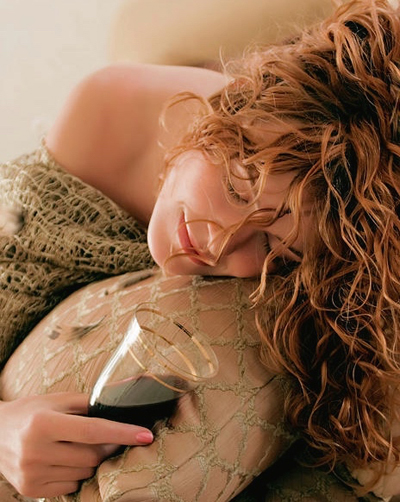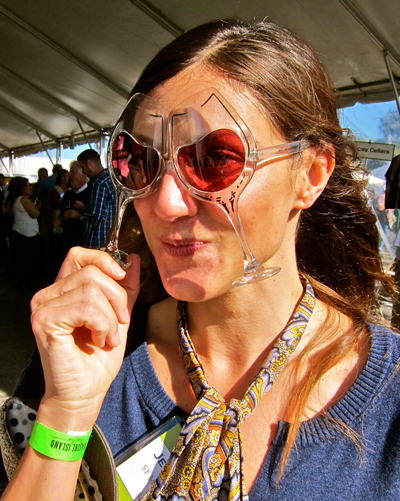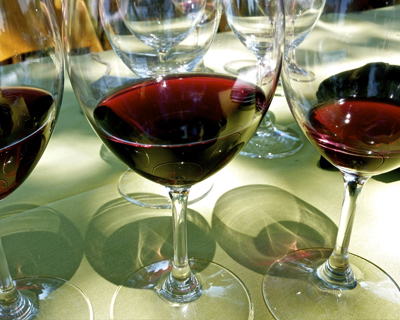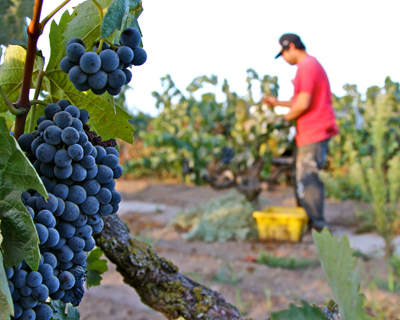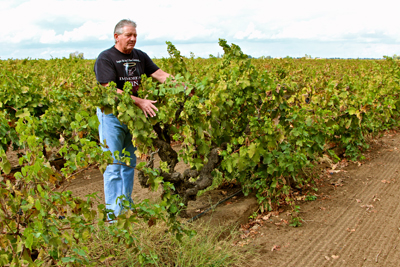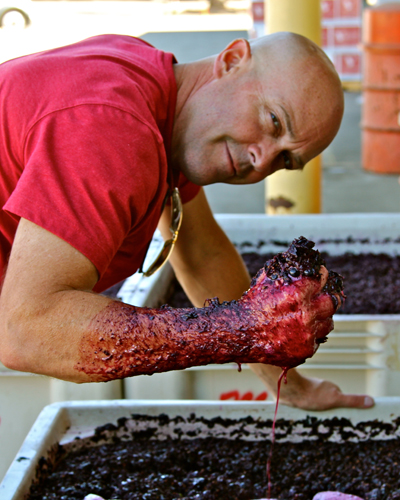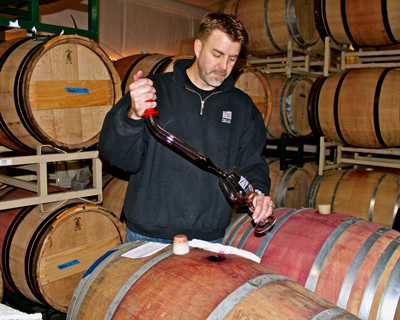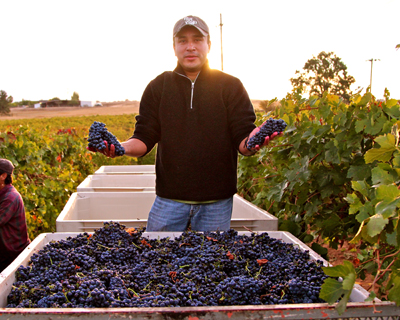Letters from Lodi
An insightful and objective look at viticulture and winemaking from the Lodi
Appellation and the growers and vintners behind these crafts. Told from the
perspective of multi-award winning wine journalist, Randy Caparoso.
Dreams of real, velvety wines (or, dream case of Lodi drinking reds)
Photo by Evgeniy Lankin (image available through fineartamerica.com)
We have this recurring dream. It’s almost mid-day. We wake up late, after some wine-soaked conversation deep into the night before, and still haven’t yet eaten. So after stopping at a tiny charcuterie for some cooked sausages, marinated olives, a round of local bread – tasting as sweet and silky as pancakes in the inside, crunchy as toasted crusts on the outside – and a bottle of wine, we follow a winding brook at the foot of a steep hill outside the village, in search of a table in the sky.
The residual chill from earlier morning hours is still sharp in the air as our shoes crunch over some loose, gravelly rocks, but we quickly begin to warm up as we steady our footing, making headway up the slope. The landscape is a primeval mix of twisted scrub, giving off resiny, herby smells as we brush against them, avoiding the lethal, gigantic sized agaves shooting up 30, 30-foot flowering spikes. The feeling is surreal.
Red-eyed Lodi wine lover
Finally, a passing brook leads us to a small, pristine pool. We feel like jumping in, but when we dip our hands into it we’re almost shocked by the icy-cold. So tucking our pack behind a rock and weighting our bottle beneath the water, we head off around a bend to catch a fuller view of the civilization below.
The sun is now just post-meridian, beginning to bathe the town's distant red roofs and winding streets in swaths of brick and gold, and beyond it the earth appears to rise and dip with misshapen squares of scattered farms, separated by taupe toned rock walls making lines between the homesteads like a Navajo blanket. Imbued by the entire fantasy, we look at each other’s smiling face and whisper those three magic words…
Shall we eat?
And if we're not yet snapped back into reality by a ringing phone or knock at the door, this is where the dream really starts to cook. The garlic and chili-spiced sausages jolt the palate, and the bread crackles and flakes; but it’s the steely cold wine – which is red (isn’t real wine red?) – that really gets us. Since we’re shooting it directly from the bottle, we’re not exactly savoring the “bouquet.”
However, the taste is like pure, undulating velvet – smooth, seamless flavors of some kind of sweet, purple stone fruit, mingling with cracked pepper, brown spices, a dangerous touch of earthiness – and the aromas rush into the head from behind the palate, even long after the wine is swallowed. Better yet is the knowing – this is our dream, mind you – that the wine was cheap, and there’s a lot more where it comes from.
Which is why, when you think of it, we feel lucky to live in a place like Lodi, with access to wines not everyone has of yet quite heard about. While dreams are nothing more than wishes, the reality is that there are always such wines to be found; despite the often overwhelming plethora of bottles and brands, at increasingly painful prices, that assault you every time you walk into a store.
Isn't real wine red?
There once was a famous Napa Valley winemaker who put it as plainly as you can: "Americans pay too much for their wine." Ironically, today it's regions like Lodi that still cling to the seemingly ridiculous (by today's standards) idea that a wine’s quality has as much to do with the honesty of its price as it does in its taste.
The basic question is, why pay $50 to $100 for a wine when you can find one you like even better for $12 to $29? What was it that Charlie the Tuna was once told? We're not looking for fish with good taste, we're looking for fish that tastes good.
Fact of the matter is, rating systems and the spectacle of brands jockeying for market positions has hoisted this other plain fact upon many an unsuspecting consumer: there is simply no correlations between the pleasure you receive and the price you pay when it comes to premium quality, commercial wine.
Yet Lodi grown wines, while not hoity-toity, effortlessly attain one of the qualities everyday consumers value the most: a sumptuous, velvety smoothness. Often enough, with a dangerous touch of earthiness, stamping their authenticity. They do this by dint of the Delta region's sandy loam soils and steady-as-she-goes Mediterranean climate; not too cool and not too hot, throughout the growing season. Grapes respond in kind; ergo, kinder, gentler, crazy-good wines.
And if you drink wines grown in Lodi – a winegrowing region which has the advantage of being the largest (in terms of acreage of classic wine grapes) in the U.S., mostly owned by the same families who have been farming the area for over 50 or 100 years – you also stand a better chance of breaking this senseless chain of excess pricing set by nattering nabobs of negativity. But not if we can help it.
It's not really a dream. Wake up and smell the Zinfandel!
Lodi Zinfandel harvest
Our favorite drinking Lodi reds
"When you go," Sheryl Crow once sang, "all I know is that you're my favorite mistake." It is a mistake to forget that good wines are for drinking, not for collecting or showing off. And great wines go great with food – they don’t clobber or overwhelm them.
So forget those overpriced hefty wines, forget the writings on the walls and tenement halls, 90 or 95-point ratings waving lasciviously at your pocketbooks like painted ladies in hot pants glowing in the dark. It's the taste of wine, stupid, that matters most.
Over recent years our favorite Lodi grown products have been red wines (isn't real wine red?) that consistently deliver because their pedigree is real – they are crafted from grapes in vineyards that know what they're doing, year-in and year-out.
Here are a dozen choices, plus a lagniappe, making up our dream case, which we highly recommend to anyone just getting into Lodi reds:
2012 Harney Lane, Lodi Zinfandel ($22) – We hesitate to describe this perennial winner as a "quintessential" Lodi Zinfandel. But it certainly has the qualifications: unfailingly perky, upbeat, smooth yet zesty aromas and flavors redolent of fresh, happy-to-see-you berries (reds veering into blue and boysen). Ironically, at least half of this wine is technically "not Zinfandel" – Harney Lane owners Kyle and Jorja Lerner sneakily blend at least 50% Primitivo (a clonal variant of Zinfandel) into their yearly "Lodi" bottling, along with small doses of Petite Sirah (usually less than 5%). The important part is the consistently delicious pleasure this wine gives as "Lodi Zinfandel."
2012 Peirano, The Immortal Zin Lodi Zinfandel ($14) – Talk about your all-time classics, this bottling stands out each year because of its ludicrous price plus its dependably bright yet soft, gushy, high-kicking raspberryish varietal character, unfettered by any excesses of alcohol, drying tannin or annoying oakiness. If you want to taste pure, unadulterated, old fashioned Lodi Zinfandel, Peirano's Immortal – made from stubby little head trained vines dating back to the 1890s – captures the very soul of that astonishing authenticity.
Lance Randolph with his Periano family’s Zinfandel, planted in the 1890s
2012 Barsetti, Lodi Zinfandel ($13) – Barsetti is another brand of Lodi Zinfandel that is incomprehensibly under-priced, under-appreciated, under-estimated. While round and fleshy, it is still just medium (not big or cumbersome) in body, exuding pure, unimpeded raspberry/blackberry fruit like a fruit-filled chocolate box confection, while emphasizing zesty natural acidity rather than hard hitting tannin or oak. But maybe we better not spread the word too aggressively – we’d just as soon keep this absolute steal of a wine to ourselves!
2013 Ironstone, Rous Vineyard Lodi Zinfandel ($28) – Every time we taste this Zinfandel we just want to cry tears of joy because a fairly good sized winery has been smart enough to let this east-side single vineyard (vines planted in 1909!) shine on its own; and because it's just so darned good and delicious. Intensely violet-like, mildly peppery, wild berry perfumes billow from the glass like a flower blossoming before your eyes; and finely etched, viscous, unencumbered varietal flavors unravel across the palate like gentle, delicious, foaming waves sliding up upon smooth tropical shores. This is what a Lodi wine lover lives for.
Lodi’s Michael McCay at his favorite activity (crushing red wine grapes)
2012 McCay Cellars, Lodi Paisley ($28) – If this blend of Zinfandel (mostly) and Petite Sirah said "Napa Valley" on the label, it would probably cost $45. Paisley is a good name for it, because it has sort of a playful, curvaceous, sexy, medium bodied texturing; silky, a little snappy, and bright in red berry perfumes and cracked sweet blackpepper (veering towards cardamom) spiciness. Winemaker/proprietor Michael McCay claims this is the best possible wine for a steak grilled with earthly/prickly, blackened Cajun spices – if that's the case, where do we sign up?
2012 Onesta, Bechthold Vineyard Cinsault ($29) – We're using the word "ridiculous" a lot, so we're going to stop it, right now. Let's describe this wine as "inconceivable" (for all you Princess Bridesters out there). Inconceivable because it tastes so soft yet tense and springy with kitchen spiced, nostril tingling strawberry rhubarb pie goodness, yet only costs $29. Inconceivable because it's made from the oldest vines in Lodi, planted in 1886. Think about it: in 1886 a young, citified dude named Teddy Roosevelt was spending his first days in the Black Hills of Dakota, looking for America. In 1886 Geronimo finally surrendered, after a 30-year chase through the deserts of Arizona and Mexico. It's ridiculous (we mean inconceivable) that you can enjoy this luscious nectar of a wine for just $29. It could be $529, but winemaker/owner Jillian Johnson DeLeon is too sensible for that. But it's that good, and that significant.
2013 Klinker Brick, Lodi Carignane ($25) – Here's a wine that comes from spectacular 106-year-old vines – truly, one of Lodi's heritage plantings – and comes across as deeply grounded as its natural rootstocks, without a sense of heaviness or clumsiness. Instead, you get fresh, lively black cherry aromas wrapped in whiffs of black tea; and upbeat flavors suggesting sweet leather and earthy dried sage. Easy to drink, yet tasting very much like the real thing – that's Lodi!
2012 Fields Family, Estate Lodi Syrah ($24) – No exaggeration, this wine easily has the intensity and depth of other American Syrahs selling for more than twice the price. In fact, it is downright regal in its purity of violet varietal perfume; underscored by notes of crushed blackberry and a finely sculpted medium-full body that is fresh, zesty, meaty and juicy at the same time. There is also a little more tannin muscle than all the other reds in our "dream" case, but more than enough characteristic Lodi lushness to stamp its origin.
Fields Family Wines’ Ryan Sherman
2012 Borra, Lodi FUSION Red ($20) – This red wine blend is as honest as they come – 100% native yeast fermented, minimally handled, and 100% estate grown by proprietor Steve Borra, a third generation Delta grower who also owns the oldest continuously active winery bond in the region (since 1975!). But like we said, it's the wine, stupid; and this one is, simply, sumptuously smooth and luxurious in aromas and flavors suggesting decadent black chocolates soaked in framboise (honeyed raspberry liqueur) – good gosh, almighty! The 2012, incidentally, is a smart blend of 60% Syrah, 20% Petite Sirah, 17% Zinfandel, and 3% Alicante Bouschet – all the things a no-nonsense Lodi wine lover adores.
2010 Viñedos Aurora, Lodi Petite Sirah ($21) – Petite Sirah lovers don't ask for much – they just want something black as night, smooth and round as a baby's bottom, and at the same time thick as a brick with flavors that knock your socks off. No problemo for Viñedos Aurora winemaker Gerardo Espinosa, who ages his powerful, family grown Petite Sirah an extra year longer in the barrel than most Petite Sirah producers in order to perfectly hone this chunky, chocolaty, peppery spiced and earthen nuanced varietal rendering – indubitably, everything (maybe even more) a Petite Sirah lover asks for.
2012 Michael David, Lodi Petite Petit ($18) – Every year this family owned winery fashions a blend of (mostly) Petite Sirah and the little-used Bordeaux grape called Petit Verdot into a wine that absolutely shames every other red wine in its price category. How can a wine so reasonably priced overwhelm the senses with so much flamboyance of rich, exuberant, plummy aromas and flavors, infused with notes of peppery beef bouillon and smoked bacon, while tasting so full yet so smooth and even keeled? Don't ask, just enjoy.
2013 St. Amant, Leventini Vineyard Lodi Barbera ($18) – You expect red wines made from the Barbera grape to have a naturally tart edge (the better to drink with zesty tomato sauced pastas!); but in Lodi's gentle environment, renditions like St. Amant's come across a little rounder and fleshier than most styles of Barbera, which can be lean and scrawny. Here, the varietal character is snappy without being sharp; the aromas lush with black cherry, veering towards strawberry; coming across as medium bodied, dry yet bouncy with an autumnal new-school-year freshness of fruit. In other words, with that Rico-suave Lodi smoothness.
2011 Vicarmont, Lodi Merlot ($20) – No matter what anyone tells you, it is still hard to find a red wine that is as velvety and pristinely voluptuous as a good, solid Merlot; and Vicarmont consistently crafts a good, solid, fantastically priced Merlot – theirs, plump with black cherry and cedar-box complexities, tasting pillowy-plush yet firm, long and chocolaty rich on the palate. A wine with thatwiggleinthewalkandgiggleinthetalk that makestheworldgoround. Praise the lord, pass the Vicarmont!
Vinedos Aurora’s Gerardo Espinosa harvesting his Lodi Petite Sirah
